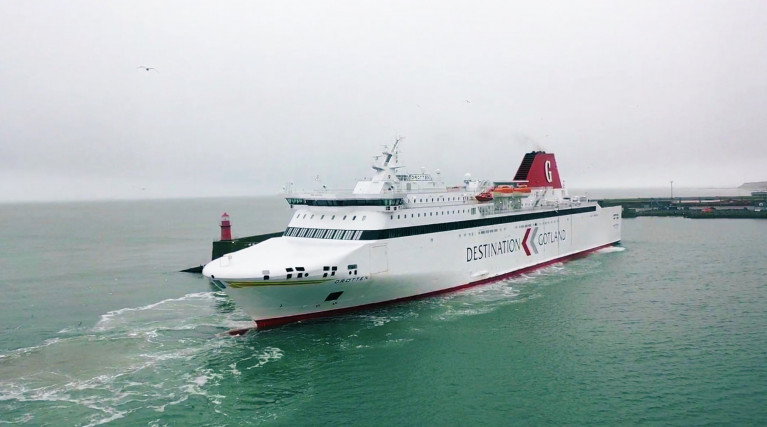Ferry changes yet again took place at Rosslare Europort as the ropax Drotten made a first arrival from Dunkirk, France, the bypass Brexit route that DFDS only launched this month, writes Jehan Ashmore.
Afloat first became aware of the Drotten when tracked at anchor off the Wexford port this morning. It transpires from further research that according to Rosslare Europort (the chartered ropax) Drotten arrived (yesterday) to replace Optima Seaways on the Rosslare to Dunkirk service.
The south-east port, notably operated by Irish Rail (Iarnród Éireann) added the Drotten will increase freight capacity on the Ireland-mainland Europe route operated by the Danish ferry and logistics company.
Afloat adds that the introduction of Drotten will also assist hauliers by addressing an inbalance in capacity logistics given the ropax is a sister of Visby which arrived to the port this morning. This ferry is also chartered from Destination Gotland, a Swedish operator serving the large island of Gotland located in the southern Baltic Sea.
Both of the Chinese built 29,746 gross registered ropax's date from 2003 will operate along with the final existing third ferry, the slightly smaller 25,263grt Kerry. The Italian 'Visentini' built ropax also dating from 2003 is of similar design to the Optima Seaways.
The ropax pair and Kerry, each have a capacity of up to 125 units. They take a mix of freight vehicles in the form of driver accompanied trucks, un-accompanied trailers which include ambiant and refridgerated units.
The trio operate an instensive 6-days a week sailing schedule on the near 24-hour duration route to the northern French port which provides hauliers a much needed alternative to the UK land-bridge. This enables clients to remain within the EU and avoid as required new UK customs and delays, though the land-bridge routes via the Irish Sea and the Port of Dover is faster and for some cargoes still remains convenient.
As for the whereabout of Optima Seaways, the 'Visentini' also built ropax, formed the only ferry of the original trio serving on the new Ireland-France route owned by DFDS. As such this ship apty made the maiden crossing.
Afloat has since tracked this morning the ropax's return to Klaipeda, Lithuania. The two-day repositioning voyage from Ireland to the Baltic state, is no surprise given Optima Seaways has since 2012 operated for DFDS on the Klaipeda route to Karlshamn in Sweden.
The Sweden-Lithuania route runs south of Gotland and so the influence of Scandinavian operators continues to be reflected strongly on the Irish ferry scene, a ro-ro role which has taken place for decades.































































